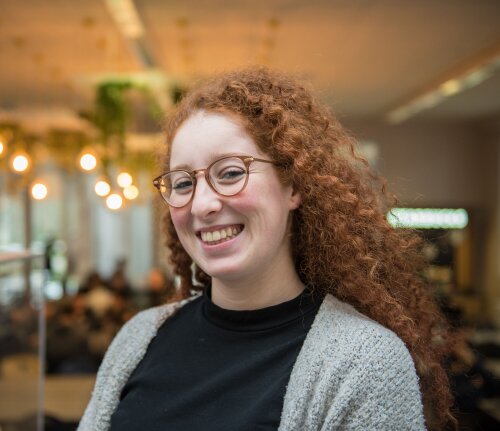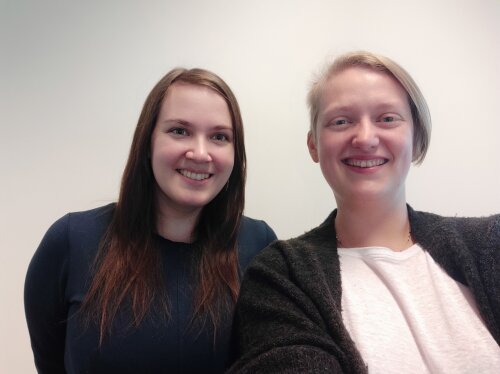UAntwerp shows its colours in the fight against sexual assault
On 25 November 2021, the International Day for the Elimination of Violence against Women, our Middelheim Campus will be coloured orange. By doing so, our university shows its solidarity for the worldwide campaign against physical and sexual aggression towards women that starts on that day. For this occasion, we give the floor to three scientists who are fighting against sexual assault with their research.
Worldwide, one in three women will experience physical or sexual assault at some point. Every day, 137 women are killed by their partners or a family member. And in the European Union, about half of women say they have experienced sexual harassment or assault at some point in their life. (Figures from UN Women) The figures look rather bleak.
‘We cannot ignore the statistics in our own country either’, says Sarah Ahannach, PhD student in Bioscience Engineering. ‘According to figures from Sensoa, there are an average of nine reports of rape every day. In 2020, there were 3,153 reports in total. In addition, only one in ten women is likely to report. One in five Belgian women claim to have previously been raped, according to a study by human rights organisation Amnesty International.’ The COVID-19 pandemic did not help the situation. Due to social isolation, economic insecurity and the reduced availability of assistance, the number of emergency calls for domestic abuse increased significantly.
Enough is enough
More and more women and men are saying that, as a society, we cannot tolerate this any longer: everyone should finally realise that sexual misconduct is never appropriate. The commotion surrounding the trial of television producer Bart De Pauw painted a clear picture in this regard, as did the recent actions in Brussels and Ghent against sexual assault in nightlife.
During ‘Orange the World’, an initiative by the United Nations, actions will take place worldwide to denounce sexual and physical violence against women: from ‘Dansen op de Dam' (Dancing on the Dam) in Amsterdam to a walking challenge to support women in Sierra Leone. The campaign runs from 25 November until 10 December, which is Human Rights Day. The theme that was chosen for this year is prevention.
Orange Your University
Sarah: ‘To draw attention to the actions, monuments around the world are being lit in orange. Universities have translated this into “Orange Your University”, an initiative in which our university is also participating for the first time this year: the A-building of Campus Middelheim will be lit orange for sixteen days. Additionally, the theme will also be covered on our social media. We hope that our actions will inspire other universities to participate as well.’
Besides this much-needed awareness-raising, Sarah believes that real action must be taken on that day. ‘Everyone should take a moment to reflect on their own working environment. Is there any inappropriate behaviour here as well? Are there any precautionary measures or channels you can report to? It is an illusion that sexual assault only occurs in nightlife or the world of sports. It is an area of attention in academia as well, although you hear hardly anything about it.’ For this occasion, we will list the channels you can report to with complaints, concerns or questions about sexually misconduct.
Additional tool for the investigation of sexual offences
At our university, a lot of research is being done on sexual assault. Sarah is involved in the Isala study, a citizen science project on vaginal health at the Laboratory of Applied Microbiology and Biotechnology. This gave rise to the subsidiary project 'GeneDoe', which hopes to contribute to the forensic investigation of rape cases. ‘Only a small minority of these cases result in a conviction, which is often due to insufficient evidence’, says Sarah. ‘Regarding this, it is interesting to know that each body zone – for example, the mouth, skin or vagina – has a unique microbiome. This consists of a set of viruses, bacteria and other micro-organisms that leave their mark on everything and everyone we come into contact with. We call this the microbial fingerprint. It might come to play an important role in sexual assault or rape cases.’
Currently when investigating sexual offences, the main objective is to find human DNA, which links an examined sample to a specific person. ‘Microbial DNA, however, could tell us what happened in more detail, by also being able to identify where on the body the sample came from. Suppose you find a mixture of semen and saliva in the vagina, that tells you a lot about what happened. We are also researching whether you could use the microbiome to determine whether there has been recent sexual activity with penetration.’
Another advantage is that the microbial fingerprint is preserved longer than human DNA. ‘This is important when the victim does not report the crime for several days. And it could also help resolve older cases’, says Sarah. The study is still in its infancy and is being conducted in cooperation with the UZA forensic laboratory. ‘We are the first research group to study this in Belgium. It would be great if we could increase the number of solved rape cases’, says Sarah.
There are an average of nine reports of rape every day in Belgium.
Sarah Ahannach, PhD student in Bioscience Engineering

Online sexual harassment
Kathleen Van Royen, postdoctoral researcher, did her PhD in Social Sciences on online sexual harassment. This is a broad term that covers a continuum of behaviours, such as inappropriate sexual comments online or suggestions to much more serious things like distributing nude images without consent, blackmailing people with a previously obtained nude photo or adults actively approaching young people. ‘The online context fuels the phenomenon because the senders feel anonymous behind their screens. They are less aware of the impact their behaviour causes because they cannot see the recipient's reaction’, Kathleen explains.
Her research focused specifically on online sexual harassment of young people on social media. ‘My surveys showed that 29.8 per cent of young people between the ages of 11 and 19 had been affected in the past six months. The typical impulsiveness of young people plays a role in this. Girls are three times more likely to experience it than boys, and LGBT youth are also more likely to be victims.’ The impact can be very big. Victims may suffer from anxiety, depression, stress, sleeplessness, eating disorders, etc. Sometimes it can even lead to suicide, as was the case for the girl from Gavere who committed a desperate act after images of her rape were spread online.
Kathleen's PhD was part of the AMiCA project, an interuniversity study on the automatic monitoring of, among other things, online sexual misconduct using image and text analysis. ‘Young people are not averse to the automatic detection of sexual harassment. This would allow moderators to intervene earlier. They also found it important for social media platforms to engage in preventive monitoring. That kind of technology could be part of the solution, although much more is needed. I am thinking of better legislation, education, awareness-raising and better support for the victims. This problem cannot be solved with just one solution’, says Kathleen.
29.8 % of young people between the ages of 11 and 19 had been affected in the past six months
Kathleen Van Royen, postdoctoral researcher

Treatment of offenders
Elise Wuyts, psychiatrist in training, also hopes that her research will contribute to a safer society in the long term. She is doing research on the guidance and treatment of sex offenders in prison, commissioned by the Minister of Justice, Zuhal Demir. This is a joint project from the University Forensic Centre of Antwerp University Hospital (UZA) and the VUB. The aim is to find out what treatment could look like and what it would take to make it successful within a prison setting. ‘Only a minority of sex offenders currently receive appropriate treatment in prison. That prison time could be put to good use. Right now, we are mainly conducting exploratory research. We are organising focus group discussions and interviews with all parties involved: social workers, security staff, management staff, but also the perpetrators themselves’, says Elise, who is working on the project with Astrid De Schutter.
Research shows that treatment reduces the risk of recidivism by an average of 37%. A treatment programme outside prison walls may be more effective than one inside. Which is not surprising: in prison, the offender does not come into contact with real life situations and cannot apply the skills learnt in therapy. It is also a challenge to conduct therapy in a safe environment, i.e. without the knowledge of fellow prisoners. Elise: ‘That does not alter the fact that an additional treatment offer in prison can be useful. By offering treatment, we can prepare offenders for their return to society and we would probably also reach more offenders.’
Elise stresses that the development of treatment has nothing to do with condoning the crime. ‘The aim is to reduce the risk of recidivism. A very large proportion of these people are struggling with themselves and want to get better. If we ignore that group, the number of sexual crimes will just increase.’
The aim is to reduce the risk of recidivism
Elise Wuyts (on the right)
